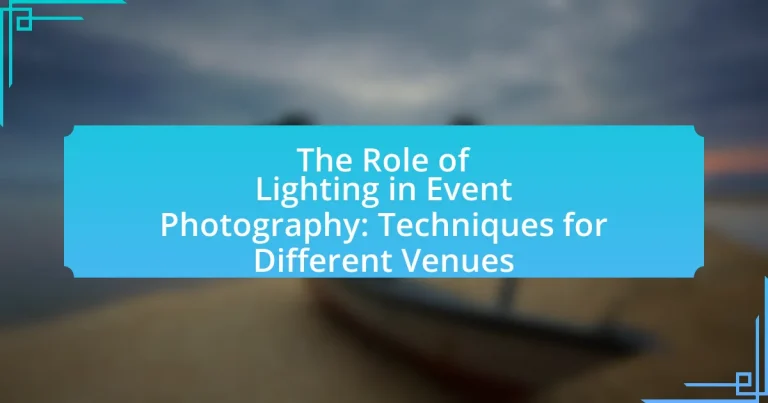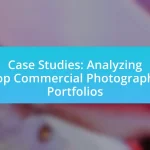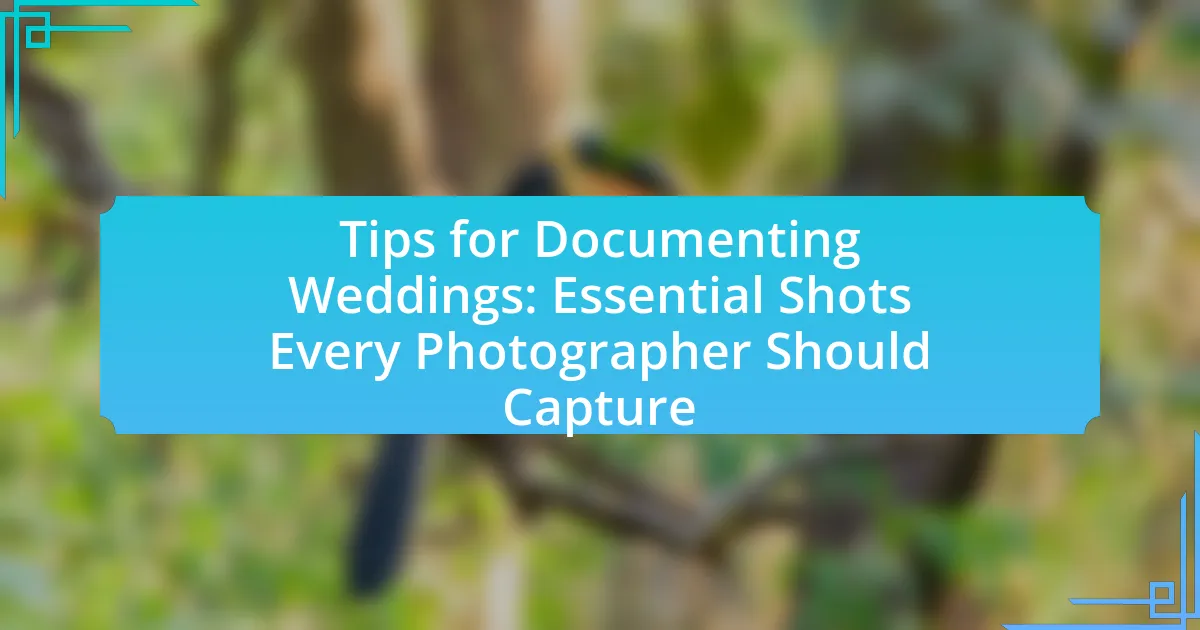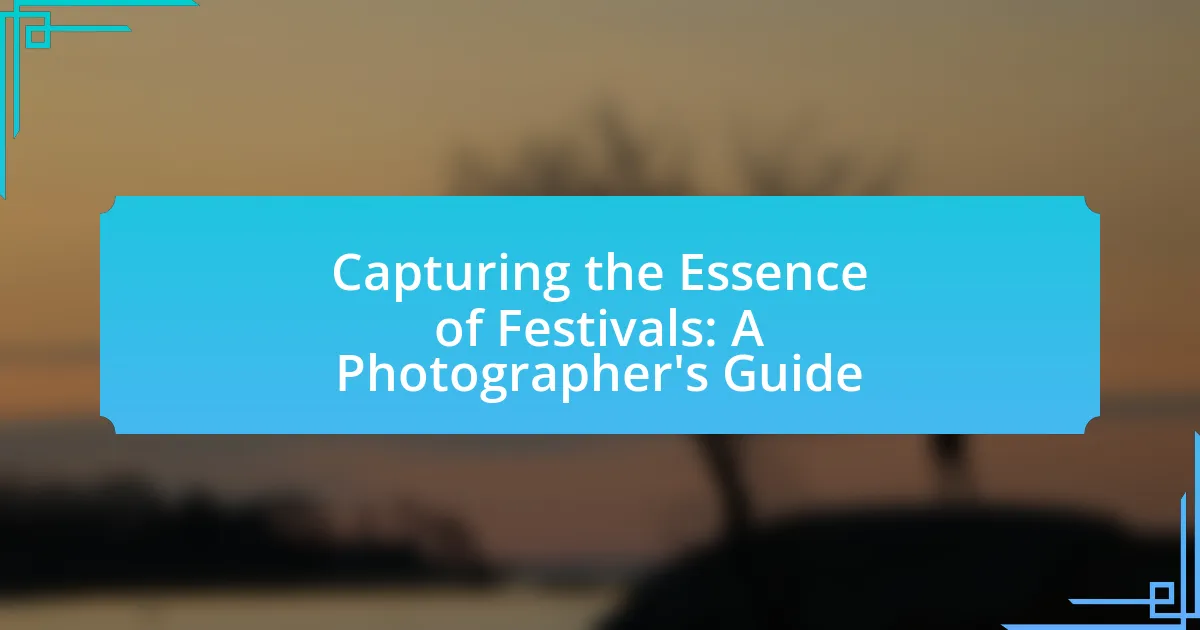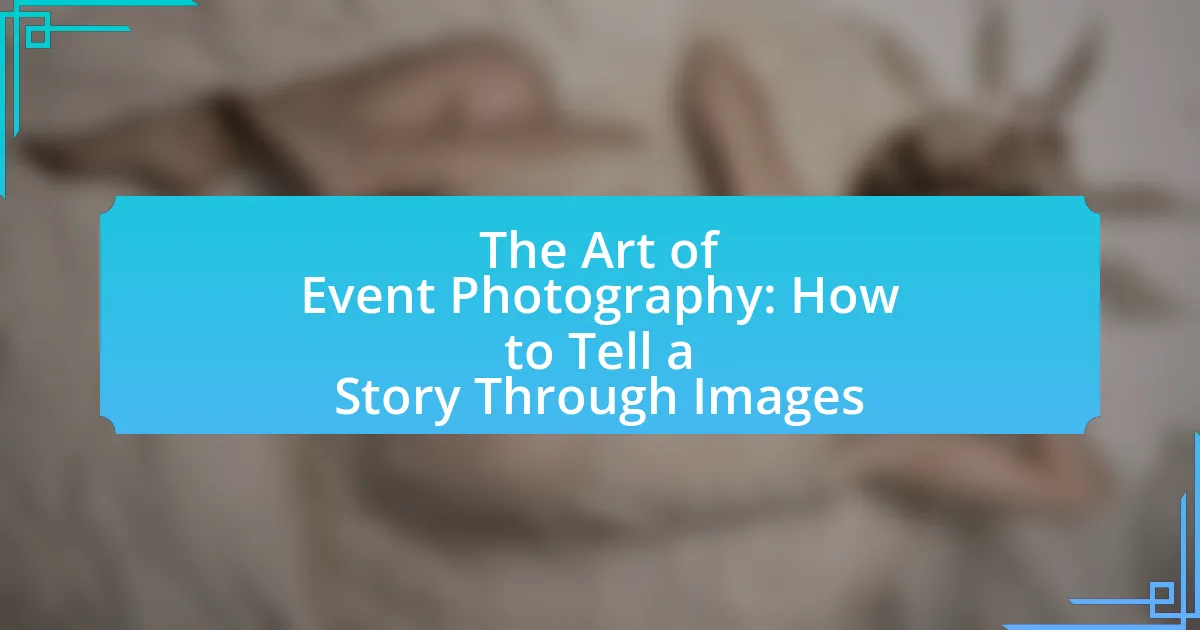The article focuses on the critical role of lighting in event photography, emphasizing its impact on mood, clarity, and image quality. It explores various lighting types, including natural and artificial light, and discusses how these elements influence the overall atmosphere of an event. Key lighting techniques essential for photographers are outlined, along with best practices for managing lighting in different venues, both indoor and outdoor. The article also addresses common lighting challenges and provides practical tips for achieving optimal results, ensuring that photographers can effectively capture memorable moments in diverse settings.

What is the role of lighting in event photography?
Lighting plays a crucial role in event photography by influencing the mood, clarity, and overall quality of images captured during an event. Proper lighting enhances subjects, creates depth, and allows for accurate color representation, which is essential for documenting events authentically. For instance, natural light can provide a soft, flattering effect, while artificial lighting can be manipulated to highlight specific areas or subjects, ensuring that important moments are well-documented. Studies have shown that well-lit photographs are more engaging and visually appealing, which is vital for event photography where the goal is to capture memorable moments effectively.
How does lighting influence the overall atmosphere of an event?
Lighting significantly influences the overall atmosphere of an event by setting the mood and enhancing the emotional experience of attendees. For instance, warm lighting can create an intimate and inviting environment, while cooler lighting can evoke a more energetic and dynamic feel. Studies show that lighting affects human emotions and perceptions; for example, research published in the Journal of Environmental Psychology indicates that different color temperatures can alter mood and behavior, impacting how guests interact and engage during the event. Thus, the strategic use of lighting not only shapes the visual aesthetics but also plays a crucial role in the overall experience of the event.
What types of lighting are commonly used in event photography?
In event photography, commonly used types of lighting include natural light, flash, continuous lighting, and ambient light. Natural light is often utilized for outdoor events, providing a soft and flattering illumination. Flash lighting, such as speedlights or studio strobes, is frequently employed to freeze motion and illuminate subjects in low-light conditions. Continuous lighting, which includes LED panels and softboxes, allows photographers to see the effect of the light in real-time, making it easier to adjust settings. Ambient light refers to the existing light in a venue, which photographers may enhance or balance with additional lighting sources to achieve the desired effect. These lighting types are essential for capturing high-quality images in various event settings.
How does natural light differ from artificial light in event settings?
Natural light differs from artificial light in event settings primarily in its source and quality. Natural light is sunlight that varies in intensity and color temperature throughout the day, providing a dynamic and often softer illumination that can enhance the atmosphere of an event. In contrast, artificial light is generated by man-made sources, such as bulbs and LEDs, which can be controlled for brightness and color but may lack the warmth and natural variation found in sunlight.
For example, studies show that natural light can create more flattering skin tones and reduce harsh shadows, making it preferable for photography during daytime events. Conversely, artificial lighting can be tailored to specific needs, such as creating dramatic effects or ensuring visibility in low-light conditions, which is essential for evening events.
Why is understanding lighting techniques essential for photographers?
Understanding lighting techniques is essential for photographers because it directly influences the quality and mood of their images. Proper lighting allows photographers to control exposure, highlight subjects, and create depth, which are critical for capturing compelling photographs. For instance, a study by the American Society of Media Photographers indicates that 80% of a photograph’s impact is attributed to lighting. Mastery of lighting techniques enables photographers to adapt to various environments, ensuring that they can produce high-quality images regardless of the venue’s natural light conditions.
What are the key lighting techniques every event photographer should know?
Key lighting techniques every event photographer should know include natural light, flash photography, and continuous lighting. Natural light is essential for capturing candid moments and can create a soft, flattering effect, especially during golden hour. Flash photography is crucial for low-light situations, allowing photographers to freeze motion and illuminate subjects effectively. Continuous lighting provides a consistent light source, making it easier to visualize the final image and adjust settings accordingly. Mastery of these techniques enables photographers to adapt to various venues and lighting conditions, ensuring high-quality images regardless of the environment.
How can lighting techniques enhance the storytelling aspect of event photography?
Lighting techniques enhance the storytelling aspect of event photography by creating mood, emphasizing subjects, and guiding viewer attention. For instance, soft lighting can evoke a sense of intimacy during personal events, while dramatic lighting can heighten tension or excitement in dynamic settings. Specific techniques, such as backlighting, can create silhouettes that symbolize themes or emotions, while colored gels can convey specific atmospheres, aligning with the event’s narrative. Research indicates that effective use of lighting can increase viewer engagement by up to 60%, demonstrating its critical role in visual storytelling.
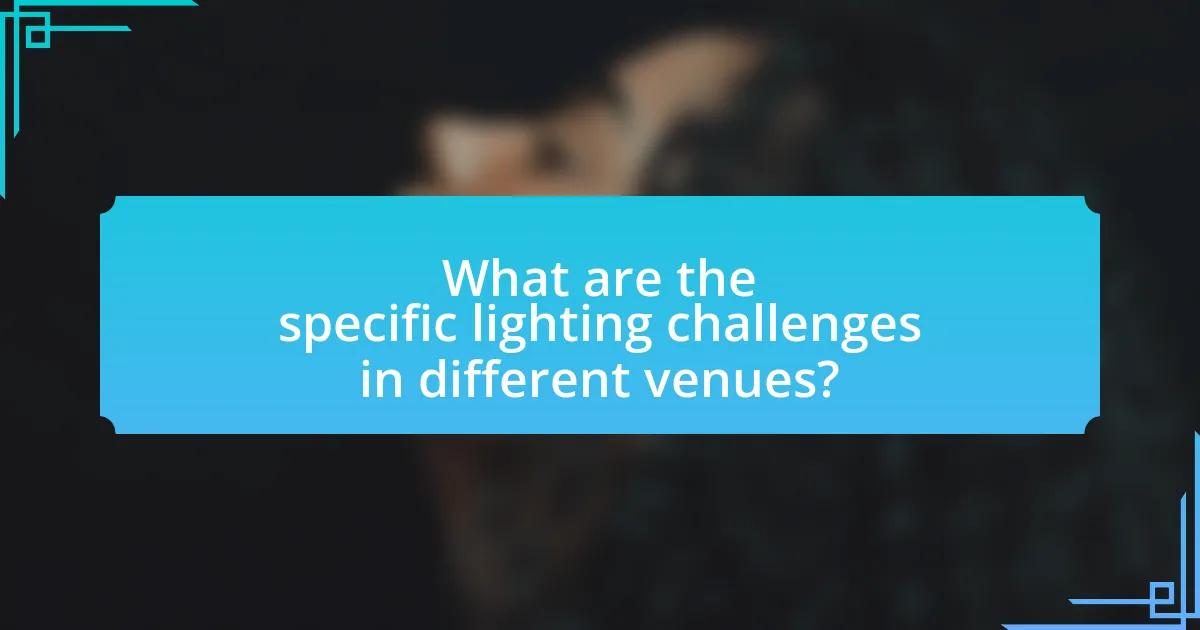
What are the specific lighting challenges in different venues?
Different venues present unique lighting challenges that impact event photography. In outdoor venues, natural light variations, such as harsh sunlight or changing weather conditions, can create inconsistent lighting. Indoor venues often face issues like low light levels, mixed lighting sources (e.g., fluorescent and incandescent), and reflections from surfaces that can distort colors. Additionally, large spaces like convention centers may have uneven lighting distribution, leading to dark areas and hotspots. Each of these challenges requires specific techniques to ensure optimal photographic results, such as using reflectors, adjusting camera settings, or employing additional lighting equipment to balance exposure.
How do indoor venues affect lighting choices in photography?
Indoor venues significantly influence lighting choices in photography due to their inherent characteristics such as size, color scheme, and available light sources. For instance, smaller venues may require the use of artificial lighting to avoid shadows and ensure even illumination, while larger spaces might allow for natural light to play a more prominent role. Additionally, venues with darker walls can absorb light, necessitating the use of brighter flashes or continuous lights to achieve the desired exposure. The presence of windows or overhead lighting also dictates whether photographers should rely on ambient light or supplement it with additional lighting equipment. These factors collectively shape the photographer’s approach to achieving optimal lighting conditions for capturing high-quality images.
What are the best practices for lighting in low-light indoor events?
The best practices for lighting in low-light indoor events include using soft, diffused lighting to minimize harsh shadows, strategically placing lights to highlight key areas, and utilizing adjustable lighting equipment to adapt to changing conditions. Soft lighting, such as LED panels or softboxes, creates a flattering effect on subjects and reduces glare. Positioning lights at various angles enhances depth and dimension, while adjustable fixtures allow for real-time modifications based on the event’s atmosphere. These practices are supported by studies indicating that well-planned lighting significantly improves the quality of event photography, ensuring that images capture the intended mood and details effectively.
How can photographers adapt to varying indoor lighting conditions?
Photographers can adapt to varying indoor lighting conditions by utilizing techniques such as adjusting camera settings, employing external lighting equipment, and using reflectors or diffusers. Adjusting camera settings involves modifying ISO, aperture, and shutter speed to optimize exposure based on the available light. For instance, increasing the ISO can enhance sensitivity to light, allowing for better performance in dimly lit environments. Employing external lighting equipment, such as speedlights or continuous lights, provides additional illumination and can help balance the overall lighting. Using reflectors or diffusers can soften harsh light and reduce shadows, creating a more flattering appearance for subjects. These methods are supported by the fact that professional photographers often rely on these techniques to achieve desired results in diverse lighting scenarios, ensuring high-quality images regardless of the conditions.
What considerations should be made for outdoor event lighting?
Considerations for outdoor event lighting include the type of lighting fixtures, the placement of lights, and the timing of the event. Selecting appropriate fixtures, such as LED lights for energy efficiency and brightness, ensures adequate illumination. Proper placement of lights enhances visibility and creates desired effects, while considering natural light conditions at different times of day is crucial for achieving optimal results. For instance, events held during sunset require adjustments to counteract diminishing daylight. Additionally, safety and accessibility must be prioritized to prevent accidents and ensure all areas are well-lit.
How does the time of day impact outdoor lighting for events?
The time of day significantly impacts outdoor lighting for events by altering the quality, intensity, and color of natural light. During the golden hour, shortly after sunrise and before sunset, the sunlight is softer and warmer, creating ideal conditions for photography with reduced harsh shadows. Conversely, midday sunlight is more intense and can produce stark shadows, making it challenging for photographers to capture flattering images. Additionally, as daylight fades, artificial lighting becomes crucial to maintain visibility and ambiance, requiring careful planning to ensure that lighting complements the event’s atmosphere. Studies in photography emphasize that understanding these variations in natural light can enhance the overall quality of event photography.
What techniques can be used to manage harsh sunlight during outdoor events?
To manage harsh sunlight during outdoor events, techniques such as using shade structures, applying sunscreen, and scheduling events during optimal times are effective. Shade structures, like tents or canopies, provide immediate relief from direct sunlight, reducing glare and harsh shadows in photography. Applying sunscreen protects skin from UV damage, which is crucial for participants and attendees. Scheduling events during early morning or late afternoon, when sunlight is softer, minimizes the impact of harsh lighting, enhancing the overall quality of photographs taken during the event.
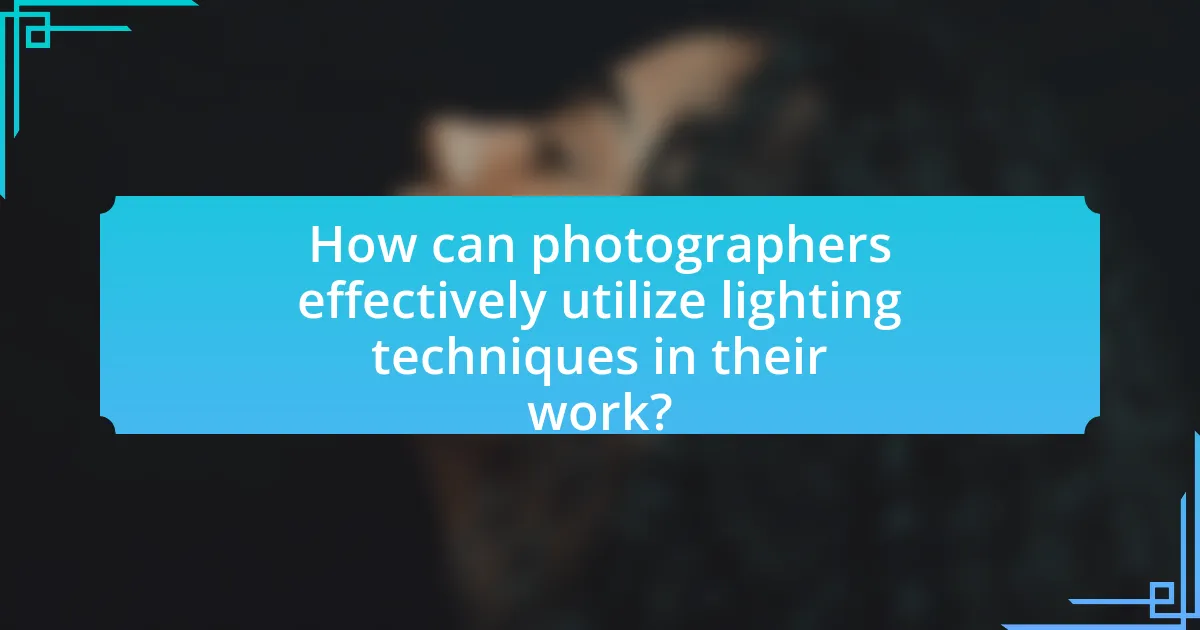
How can photographers effectively utilize lighting techniques in their work?
Photographers can effectively utilize lighting techniques by understanding and manipulating natural and artificial light sources to enhance their compositions. For instance, using soft, diffused light can minimize harsh shadows and create a more flattering appearance for subjects, while hard light can add drama and texture to images. Additionally, photographers can employ techniques such as backlighting to create silhouettes or rim lighting to highlight edges, which adds depth to the photograph.
In event photography, adjusting the white balance according to the lighting conditions—such as tungsten or fluorescent—ensures accurate color representation. Furthermore, utilizing reflectors and diffusers can help control light direction and intensity, allowing photographers to achieve the desired mood and atmosphere. Studies show that effective lighting can significantly impact the emotional response of viewers, making it a crucial element in storytelling through photography.
What are the best lighting setups for different types of events?
The best lighting setups for different types of events include soft, diffused lighting for weddings, dramatic spotlights for theatrical performances, and vibrant colored lights for parties. Weddings benefit from soft lighting to create a romantic atmosphere, often achieved with softboxes or LED panels. Theatrical performances require focused spotlights to highlight actors and set pieces, utilizing ellipsoidal reflector spotlights for precision. Parties thrive on dynamic colored lighting, often implemented with moving head lights and LED strips to energize the environment. These setups are validated by industry standards, where soft lighting is recommended for emotional events, focused lighting for performances, and colorful lighting for celebrations to enhance the overall experience.
How can photographers create dramatic effects using lighting?
Photographers can create dramatic effects using lighting by manipulating the direction, intensity, and color of light. For instance, using low-angle lighting can cast long shadows, enhancing the sense of depth and drama in an image. Additionally, high-contrast lighting, achieved through the use of spotlights or harsh light sources, can emphasize textures and shapes, creating a more dynamic composition. Color gels can also be employed to alter the mood of a scene; warm tones can evoke feelings of comfort, while cool tones can create a sense of tension. These techniques are supported by the principles of light and shadow, which have been extensively studied in photography, demonstrating that effective lighting can significantly impact the emotional response of viewers.
What role does color temperature play in event photography lighting?
Color temperature significantly influences the mood and atmosphere in event photography lighting. It determines the warmth or coolness of the light, affecting how colors are rendered in photographs. For instance, a lower color temperature (around 2700K to 3000K) produces warm, yellowish light, ideal for creating a cozy ambiance at events like weddings or parties. Conversely, a higher color temperature (above 5000K) yields cooler, bluish light, which can enhance clarity and detail in environments such as corporate events or exhibitions. Accurate color temperature management is essential for achieving natural skin tones and vibrant colors, as improper settings can lead to undesirable color casts, impacting the overall quality of the images captured.
What tools and equipment are essential for managing lighting in event photography?
Essential tools and equipment for managing lighting in event photography include external flash units, light modifiers, reflectors, and continuous lighting sources. External flash units provide additional light to enhance exposure in low-light conditions, while light modifiers such as softboxes and umbrellas diffuse light for a softer effect, reducing harsh shadows. Reflectors help bounce existing light to fill in shadows and create a more balanced exposure. Continuous lighting sources, like LED panels, offer consistent illumination, making it easier to visualize the final image during setup. These tools are critical for achieving optimal lighting conditions tailored to various event environments.
What types of lighting equipment should every event photographer have?
Every event photographer should have a combination of on-camera flash, external flash units, and continuous lighting sources. On-camera flash provides immediate illumination for subjects, while external flash units allow for more creative lighting setups and can be positioned away from the camera for better angles. Continuous lighting sources, such as LED panels, offer consistent light that helps photographers see how shadows and highlights will appear in real-time. These tools are essential for adapting to various venue conditions, ensuring that photographers can capture high-quality images regardless of the lighting environment.
How can modifiers enhance lighting quality in event photography?
Modifiers enhance lighting quality in event photography by controlling the direction, intensity, and diffusion of light. For instance, softboxes diffuse harsh light, creating a softer and more flattering illumination on subjects, which is crucial in capturing natural-looking skin tones. Additionally, reflectors can redirect light to fill shadows, ensuring even exposure across the scene. Research indicates that using modifiers can reduce the contrast in images, leading to a more balanced and aesthetically pleasing result, which is particularly important in dynamic environments like weddings or corporate events where lighting conditions can vary significantly.
What practical tips can improve lighting in event photography?
To improve lighting in event photography, utilize external flash units and reflectors to enhance illumination. External flash units provide greater control over light direction and intensity, allowing photographers to avoid harsh shadows and achieve a more balanced exposure. Reflectors can bounce existing light onto subjects, softening shadows and creating a more flattering appearance. Additionally, adjusting the camera settings, such as increasing the ISO or using a wider aperture, can help capture more light in low-light environments. These techniques are supported by the fact that professional photographers often rely on external lighting equipment to achieve optimal results in various settings, ensuring that subjects are well-lit and details are captured effectively.
How can photographers troubleshoot common lighting issues during events?
Photographers can troubleshoot common lighting issues during events by adjusting their camera settings, utilizing external lighting equipment, and modifying their shooting angles. For instance, increasing the ISO setting can help capture more light in low-light conditions, while using a flash or portable LED lights can provide additional illumination when ambient light is insufficient. Additionally, changing the shooting angle to incorporate available light sources, such as windows or overhead lights, can enhance the overall exposure and reduce harsh shadows. These methods are effective as they allow photographers to adapt to varying lighting conditions, ensuring high-quality images regardless of the venue’s lighting challenges.
What are the best practices for balancing ambient and artificial light?
The best practices for balancing ambient and artificial light include assessing the existing light conditions, using adjustable artificial lighting, and employing color correction techniques. Assessing the existing light conditions allows photographers to understand the ambient light’s quality and intensity, which is crucial for achieving a natural look. Using adjustable artificial lighting, such as softboxes or LED panels, enables photographers to match the intensity and direction of the ambient light, creating a cohesive lighting environment. Employing color correction techniques, such as using gels or adjusting white balance settings, ensures that the color temperature of artificial light complements the ambient light, resulting in a harmonious blend. These practices are supported by the principle that effective lighting enhances the overall quality of event photography, as demonstrated in studies highlighting the importance of light balance in capturing realistic and engaging images.












